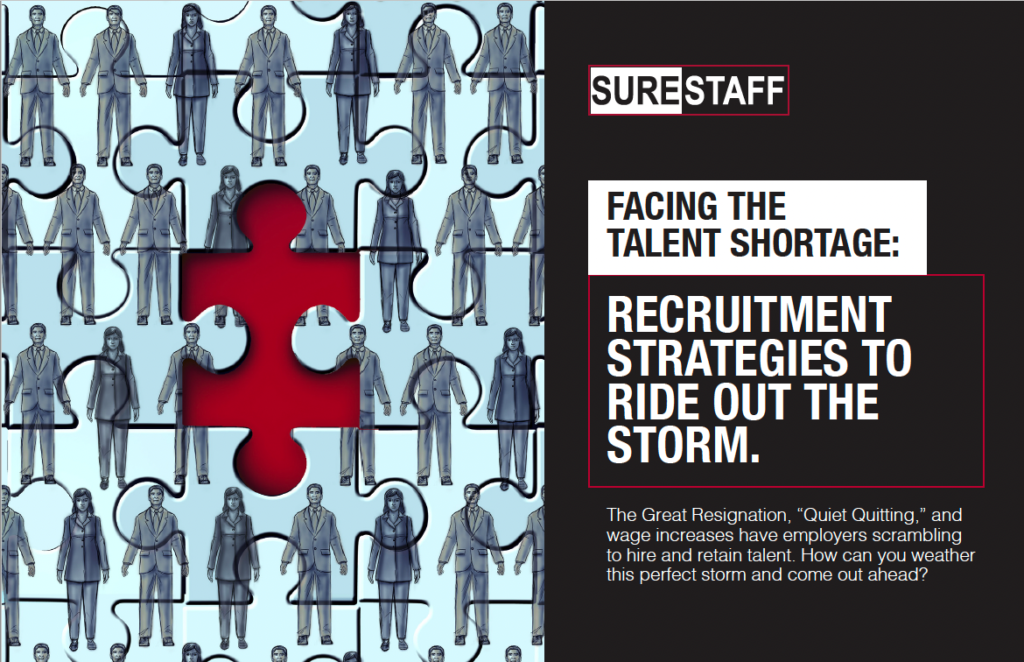The Real Cost of Hiring New Employees (and bad employees)
Hiring a new employee is one of the most important investments that a company can make. The recruitment process should not be rushed and can be complex, yielding a costly, but a necessary investment for your business. It’s important to understand the real cost of hiring a new employee – and the cost of hiring a bad employee.
According to new benchmarking data from the Society for Human Resource Management (SHRM), the average cost per hire was nearly $4,700.
In this article we discuss the typical costs associated with hiring a new employee and the cost of losing an employee. We’ll also present a discussion of a cost-benefit analysis — providing an accurate view of the financial investment to expect when bringing on a new employee.
“The cost of hiring or replacing employees is no minor line item, yet it’s often ignored. The high costs of recruitment shouldn’t just be accepted as a part of doing business, “says Bluecrew Chief Customer Officer, Matt Laurinas.
Cost to hire
Many employers estimate the total cost to hire a new employee at three to four times the position’s annual salary. This means that if you’re hiring for a job that pays $50,000 annually, you could potentially spend $150,000 or more when filling that role.
“Of those costs, I would say 30 percent to 40 percent are hard costs, and the other 60 percent are soft costs,” said Edie Goldberg, founder of E.L. Goldberg & Associates and the SHRM Foundation chair-elect.
Typical hiring costs
Many factors can impact the cost of your recruitment and hiring. The following list includes but is not limited to some of the most common expenditures. These costs vary from business to business:
- Internal HR team salaries
- Advertising writing, development, and design
- Job boards, licenses, job postings, and engagement tools
- Candidate screening
- Resume reviews
- Telephone interviews
- In-person interviews
- Background checks and security clearance
- Salary, benefits, and bonus
- Onboarding
- Training
- Corporate equipment and credentials
- Referrals
Calculating cost per hire
Here’s a common equation to assist you in calculating cost per hire: Total number of hires (by fiscal period) / total recruitment cost (in the same period) = cost per hire. Using this formula, if you hired 25 people in a specific period and your total recruitment cost was $100,000, then your cost per hire is $4000.
According to the background screening company, ScoutLogic, a good benchmark for the cost per hire is anywhere between $2,000 to $5,000. This figure will of course vary based on the industry, size, how you expediate or speed the process, and location of your business.
Other Hard Costs
For most companies with reasonable HR and recruiting support, the time and energy to recruit new staff goes well beyond the soft costs of the process.
In addition to salaries, office space, telephone and communications costs, there are real hard costs related to the recruiting and search process. Here are some typical monthly costs for a mid-sized firm… totally about $11,650 per MONTH!
- LinkedIn Licenses $500
- Linked In Boosts $1,000
- Internal Job Boards $500
- Indeed Licenses $1,000
- ZipRecruiter ads $500
- Craigslist ads $1,200
- Indeed Jobs PPC $6,000
- Candidate Engagement $600
- Onboarding tools $350
Miscellaneous Hard Costs
Of course, there are more costs required for the direct hire process. These vary from firm to firm and some may not be valid; but, these costs are real. In any type of hiring cost analysis these must be considered.
- Training

- Candidate Research
- Customer and Applicant Resource Management (CRM & ATS)
- Advertising development and design
- Design software and tools
- eSignature capability
- Social media management and software
The cost of losing an employee
We’ve discussed the financial investment associated with hiring a new employee, but on the flip side, losing and having to replace an employee can also be quite costly. According to SHRM: Replacing an employee can cost between 50% – 60% of that employee’s salary with the overall costs ranging anywhere between 90% – 200%. That’s a pretty significant hit and further supports why you should consider outsourcing the recruiting and search process.
Cost of a Bad Hire
Bad hires cost organizations hundreds if not thousands of dollars on average. That’s why hiring the right person is critical to limit unnecessary spending in limiting the cost associated with (Recruitment, Interviewing, onboarding, and training).
On average the U.S. small Business Administration (SBA) found that the cost to hire a new worker is 1.25 – 1.40 Xs the annual salary.
In addition to the hard cost associated with hiring it’s important to consider the effect that bad hires have on the current staff when a new hire doesn’t work out. Bad Hires create static with high performing individuals which come in the form of extra workloads, leading to employee burn out and eventually turn over. So, it’s important you do everything possible to ensure a successful new hire.
EXAMPLE: The Bad Salesperson
Though there are many other examples, we have found the cost of hiring a bad (or under-performing) salesperson is the costliest. Consider all the expenses we have discussed above – direct, indirect, hard, and soft – the poor-performing salesperson has their own pitfalls:
- Compensation: It usually takes 6 months to discover a salesperson is not good…so, before that person is terminated or voluntarily leaves, you have paid that person 6+ months of salary and benefits. For a typical salesperson with an $80,000 base salary, you have spent $50,000 (with benefits and burden costs).
- Opportunity Cost: Salespeople are hired to sell. If a salesperson is under-performing (or not at all), you have lost (or not gained sales). Depending on your industry, that can mean millions of dollars in lost revenue and lost sales effort.
- Wash and Repeat: In this scenario, you now have to repeat the process. We have found it takes 3-6 months to find a good candidate. You still have all the direct and indirect costs related to the search, and you have a 6+ month window in front of you to see if the person “works out” or for them to get up to speed with an acceptable sales pipeline.
- Mentoring and Training: Best practices for new sales folks require a commitment to training – related to your industry, company, services, and fundamental sales techniques. For some businesses, this can mean months of formal training and mentoring, and support provided by expensive sales team members and managers.
- Morale Damage: Of the position we routinely hire for, losing or having to terminate a poor salesperson impacts the organization the most. Besides the typical reaction to a termination, staff are enthused by what is represented by a new salesperson – growth, sales, revenue, profitability, and progress. When that person leaves that enthusiasm is lost – at least temporarily.
“All told, hiring a bad salesperson can put you back in the process as much as a year with wasted compensation, benefits, and recruiting costs, as well as lost opportunities and sales”, Tim Faber, CEO Surestaff LLC, a nationwide, Chicago-based staffing firm
The Effects of Attrition
Employee retention is a huge issue in the workforce, as turnover is inevitable in any business. Retaining employees from the start is key because attrition can be very costly and detrimental to an organization. Attrition, however, should be considered in your hiring plans.
When a company is faced with high turnover rates, it inevitably influences employee morale, productivity, and engagement. Businesses lose money when employees leave, whereas the cost of attrition should also be calculated. This rate can be determined by taking the number of employees that separated from the company in a given year and dividing that by the average number of employees during that year. It can be very expense, especially if you have invested heavily in learning and development opportunities for your employees.
Turnover costs
Employee turnover costs are typically broken down into the following cost calculations:
- Employee cost – total compensation including salary and benefits
- Vacant coverage cost – number of days the position remains open
- Cost to fill vacancy – advertising, screening, background checks, etc.
- Training and orientation cost – trainer or hiring manager’s onboarding time
- Ramp up cost – ramp up learning period
Wrap-Up

Getting around the cost of hiring in not possible! However there is a solution available to you that can reduce the amount of money spent upfront identifying qualified talent and delivers improved new hire retention.
At Surestaff we have a senior team of recruiters with 20 plus years of experience that understand the importance of getting your search right! It is part of the reason why you should use Surestaff for your next hire.
Knowing what you need is a critical piece of the complex puzzle and that is why we invest a great deal of time getting to know your business. In doing so, we are able to proactively source passive candidates that meet the specific “must haves” for each role, while hitting the mark for successful cultural fits within your business.
In 2022 our clients have successful successfully hired and retained 94% of Surestaff candidates placed. Making us one of the industry leaders in the Direct Hire Recruitment space.
To learn more about the Surestaff difference and how we will reduce recruitment overhead cost and improve retention, CONTACT US: Your Success Is Our Mission! sure-staff.com | DH@sure-staff.com | 630-483-1600
About the Author
Kim is a seasoned content marketing professional with over twelve years of corporate communications experience. Her sweetspot is with creative writing both short and long-form. She has a proven track record working with IBM, Jackson Healthcare, and Walt Disney World, among others. Kim is a singer and actress and has been performing on stage and screen her entire life and has a great passion for TV and film production. Connect with Kim on LinkedIn.
creative writing both short and long-form. She has a proven track record working with IBM, Jackson Healthcare, and Walt Disney World, among others. Kim is a singer and actress and has been performing on stage and screen her entire life and has a great passion for TV and film production. Connect with Kim on LinkedIn.

